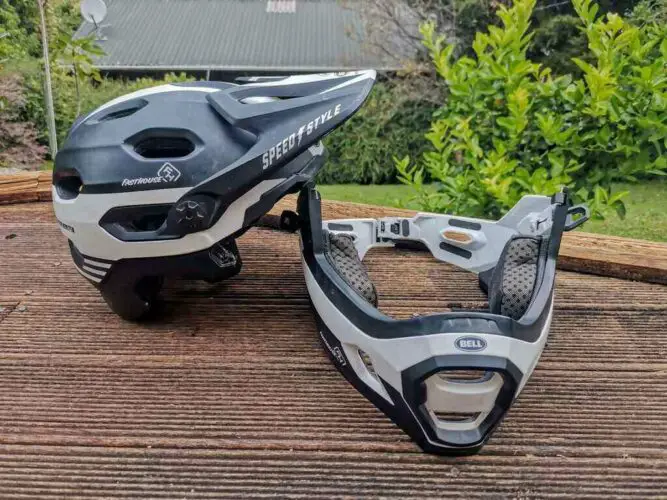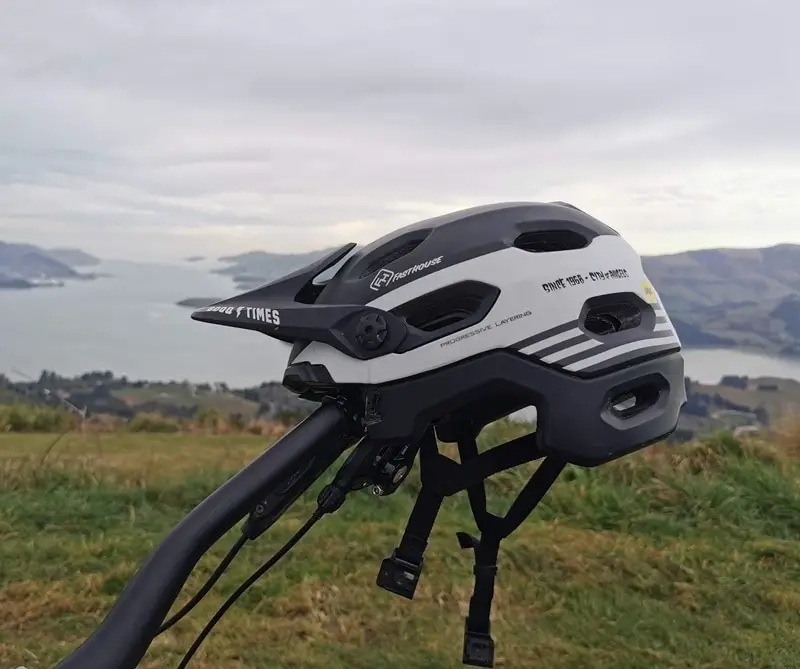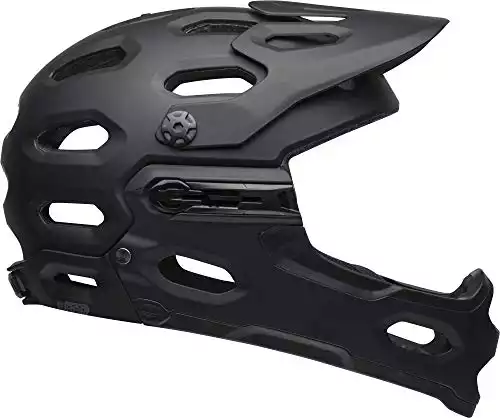Here we have two outstanding helmets in the convertible helmet market, the Bell Super 3R vs Leatt DBX 3.0. The two helmets are very similar, but we will be looking into the details to see which one takes the win.
The helmets will be compared side by side, indicating the vital advantages and flaws over one another. There is never one helmet that does it all for all riders. We are looking to find the helmet that suits you and your style of riding!
Rating
Weight
Downhill Certified
Rotational Impact System
Bell Super 3R
4/5
784 g
No
MIPS
Leatt DBX 3.0
4/5
760 g
No
Turbine 360
Keep reading for the Bell Super 3R vs Leatt DBX 3.0 comparison!
Leatt DBX 3.0 Enduro Mini Review
Pros
- Turbine 360 Technology
- Well Ventilated
- Lightweight
Cons
- Not Downhill Certified
- Flimsy Reattachment of Chin Bar
Starting with the Leatt DBX 3.0 Enduro, we have a well ventilated, comfortable and breathable helmet. It is aimed at the enduro rider- comfortable, but prepared for a collision. It weighs in at only 760g for a medium with the chin bar attached.
The DBX 3.0 offers Leatts Turbine 360 technology, which reduces the impact in an angular or rotational crash (similar to MIPS technology). This reduces the chances of brain damage resulting from the collision. It has the advantage that the turbines actually reduce linear impacts as well- which MIPS does not. This means you aren’t just relying on the EPS foam layer to reduce impacts to your skull.
Bell Super 3R Mini Review
Well ventilated, very light, and very comfortable. This is the ideal helmet for the typical rider, not riding the extreme lines at extreme speeds, but wanting more protection than an open-face helmet can provide.
Pros
- Comfortable
- Well Ventilated
Cons
- Not Downhill Certified
The Bell Super 3R was the successor of the Super 2R and preceded the Super DH. The 3R is essentially a more refined, more comfortable version of the 2R, and is the lighter, more ventilated version of the DH.
The Super DH is fully downhill certified, whereas the 3R doesn’t quite have enough bulk to meet those specifications (read more about this below in the safety comparison). It is still fully certified to the usual helmet safety standards though!
Construction and Design Comparison
Both are constructed in-mold, which is a fusion of the polycarbonate shell to the EPS foam layer. This makes the helmet more durable and less likely to come apart in a crash. The attachment mechanism for the Super 3R is found above the ears and around the rear of the head. Whereas the DBX 3.0 is around the back of the ears, and slides into place seamlessly.
The main issue we have seen with the attachment system on the DBX 3.0 is that it can be a bit flimsy. The durability of the buckle may not last as long as Leatt would have liked, and would recommend taking extra care around the buckle system while handling it.
In terms of style, the chin bar of the Super 3R looks slimmer, the shell a bit more rounded and the vents are more circular than the DBX 3.0. This gives it a well-structured look like the ventilation took priority in the design stage.
The attachment system on the Super 3R is also a little more obvious from the side on view if you purchase a colour other then black. From the side view, the Leatt DBX 3.0 seems to attach a bit more seamlessly between the chin bar and the main shell, whereas the Super 3R has a bit flatter edge. In open face mode, both helmets have similar rear coverage, and the visors on neither helmet look too large without the chin bar.
The style of the helmet is completely up to personal preference. However, we like the look of the DBX 3.0 as it has a bit more of an angular, clean, and fast feel to it, and it looks really good in both full face and open face mode.
Safety Comparison
Neither helmet is ASTM downhill certified (ASTM F1952), but both are certified for regular helmet safety standards (CPSC/EN1078). What does this mean? It simply means that the coverage of the head and impact performance of the helmet is not sufficient enough to meet the downhill standards.
This does not mean the helmets are unsafe to ride in, just that we wouldn’t be taking on Red Bull Rampage style riding without a downhill certified helmet. The chin bar certainly adds to the protection of a helmet, and you are likely to come off better out of a crash wearing a chin bar than not.
The safety features of the two helmets are very similar. They both contain anti-rotational impact systems which reduce the angular rotation of your brain within your skull in the event of an impact, reducing the possibility of brain damage.
The Bell Super 3R has MIPS, the more well-known anti-rotational impact system, which acts as a low friction slip plane allowing the shell to take the brunt of the force in a collision.
The Leatt DBX 3.0 has Leatts Turbine 360, which is effectively small round pads which spin to absorb angular energy and also deform to reduce direct impacts. Both are very good at reducing the energy from an angular impact, but the Turbine 360 has the advantage of reducing linear impacts as well.
Both have decent coverage around the rear of the head and are very similar in this respect. The larger the coverage, the more protected the rear of your head will be if it hits the ground and prevents sticks or sharp rocks penetrating the back of your head.
Comfort, Ventilation and Weight Comparison
In terms of ventilation, there are 18 vents on the DBX 3.0, including one above the brow line which draws in air as you ride, circulating it through the helmet to keep the head cool. There are a couple more vents on the chin bar and above the ears in an attempt to reduce the heat build-up once you are riding in full-face mode.
In comparison, the Super 3R has a few more vents, with 23 vents on the helmet, including an overbrow ventilation. It has 6 vents on the chin bar to also circulate the air through the system well. The advantage of the DBX 3.0 is that the vents are actually covered with a screen which prevents dust and small particles entering and clogging up the airflow system.
The Leatt DBX 3.0 helmet is lighter, weighing in at 750g with the chin bar (size medium), which is about 30g lighter than the Bell Super 3R. While this is unlikely noticeable while riding, it is a bit of a bonus for the DBX 3.0!
The Super 3R has Bell’s more recent Float Fit system which improves the comfort of the fit. This is a complete remake from the Super 2R, offering a minimalist, lightweight fitting system which holds the helmet snugly to your head. It is integrated well with MIPS and is simple to adjust, using an easy-to-turn rubber dial to adjust while riding.
The DBX 3.0 has also done well in integrating the turbines with the ventilation and comfort of the helmet. The turbines are little blue rubber pads which sit against the head. They are soft to touch, and you can’t really feel them once the helmet is on your head. Don’t worry, they don’t get caught in your hair, nor do they stick to bald heads!
Features Comparison
The Bell Super 3R takes out the features comparison. It is goggle compatible, has a breakaway camera mount, and features the cleverly designed ‘No-Twist Tri-Guides’ system. The strap system makes the Fidlock magnetic buckle system even more seamless to use.
The DBX 3.0 isn’t lagging behind too far though! It also features the Fidlock magnetic buckle system, and also has a breakaway visor, a washable liner and is hydration ready. The only real disadvantage is that it can only fit small goggles or a pair of glasses beneath the visor for storage, so you will need to keep the goggles around your neck for the climbs for now.
Conclusion
The Bell Super 3R is generally the more popular option, given Bell’s superior reputation and the large colour range. However, both are very reputable brands, with certifications you can trust, and they cost roughly the same.
But who comes out on top in the Bell Super 3R vs Leatt DBX 3.0 comparison?
There is no clear winner here as the two helmets are so similar in most ways. But (because I promised a winner..) if it were up to us, we would go with the Leatt DBX 3.0. It has a few more safety features. And we like the sleek, angular look of the DBX.
However, the Bell Super 3R is one of the most comfortable helmets on the market. It comes with additional padding if it has some areas that don’t fit snugly enough for your liking. And it costs just a little less!
Well ventilated, very light, and very comfortable. This is the ideal helmet for the typical rider, not riding the extreme lines at extreme speeds, but wanting more protection than an open-face helmet can provide.
Another option worth considering is the Bell Super DH if you are looking for something a little more protective. Or see the comparison between the Bell Super 3R and the Super DH here.

For more convertible mountain bike helmets check out our top 4 convertible mountain bike helmets (I promise it is a worthwhile read if you haven’t decided what helmet you want yet!)
Or, if you think a full-face will be more suitable, check out our pick of the most ventilated full-face helmets.

